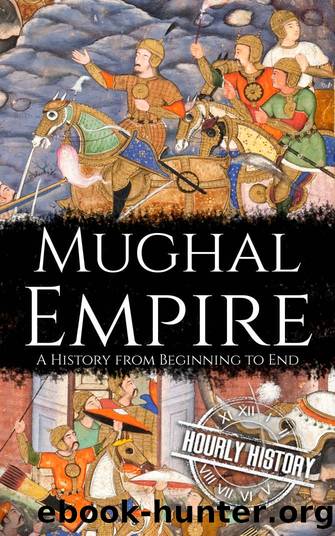Mughal Empire: A History from Beginning to End by Hourly History

Author:Hourly History [History, Hourly]
Language: eng
Format: epub
Published: 2020-05-31T00:00:00+00:00
Chapter Six
Art, Architecture and Science in the Mughal Empire
âThe Taj Mahal rises above the banks of the river like a solitary tear suspended on the cheek of time.â
âRabindranath Tagore
Art and architecture both flourished in the Mughal Empire and especially in the period from 1556 to 1707. Humayunâs forced exile in Persia exposed him to the intricate and ornate art of the Safavid Empire, and he returned with an appreciation for that style and with a Persian wife. From that time on, the stylistic influences on Mughal art were a unique fusion of Timurid, Indian, and Persian, which created something new and distinctive.
Humayunâs early and unexpected death gave him little time to appreciate these things after he was able to restore the fragmented empire but his son, Akbar, was able to devote some of his considerable energy to the creation of breathtaking public architecture. Humayunâs tomb, commissioned by Akbarâs wife Hamida Banu Begum in 1652, is one of the best-known examples of the architecture which emerged under Akbar.
This was the first garden tomb in the Indian subcontinent and was designed by a Persian architect. It was constructed almost entirely of red sandstone (the first large building to use this expensive building material) topped by a dome of polished white marble. The overall design is recognizably Islamic, but this is melded with indigenous Rajasthani decorative elements including ornate inlaid patterns created from small pieces of stone. This fusion of Persian and Indian styles became a feature of virtually all the large architecture projects overseen during the long reign of Akbar.
One of the most notable projects was the construction of Akbarâs royal city, Fatehpur Sikri, which included a mosque of unusual design, featuring a prayer hall with a shallow dome and a vast central courtyard accessed through the Buland Darwaza, the largest gateway in India at the time of its construction.
By the time of Akbarâs death in 1605, the fusion of style elements with origins including Persian, Turkic, Timurid Iranian, Central Asian as well as Indian Hindu and Muslim had produced a rich, ornate, and opulent new look which was continued by Jahangir whose contributions included the tomb of Itmad-ud-Daula and the great mosque at Lahore.
Yet it was under the next Mughal emperor, Shah Jahan, that the best-known expressions of Mughal architecture were produced. Buildings of complex design, richly decorated with inlays and patterns of bewildering complexity, these are embodiments of the wealth and power of the now vast empire. The Taj Mahal remains the best-known creation from this period, but the Jama Masjid in Delhi, the Moti Masjid in Agra Fort, and the Sheesh Mahal in Lahore Fort are equally striking and beautiful.
It is unsurprising that during the reign of the austere and pious Aurangzeb, there was less focus on the creation of ornate and expensive public buildings though the Badshahi mosque is attributed to him and includes novel construction featuring bricks faced with red sandstone. After Aurangzeb, the declining fortunes of the Mughal Empire left little spare income or resources for the creation of vast public buildings.
Download
This site does not store any files on its server. We only index and link to content provided by other sites. Please contact the content providers to delete copyright contents if any and email us, we'll remove relevant links or contents immediately.
| Africa | Americas |
| Arctic & Antarctica | Asia |
| Australia & Oceania | Europe |
| Middle East | Russia |
| United States | World |
| Ancient Civilizations | Military |
| Historical Study & Educational Resources |
The Battle of Mogadishu by Matt Eversmann & Dan Schilling(723)
The Confidence Men by Margalit Fox(671)
A History of the Muslim World since 1260: The Making of a Global Community by Vernon O. Egger(641)
The Spymaster of Baghdad by Margaret Coker(641)
Jack the Ripper and the East End by Peter Ackroyd(610)
Empire of Fear: Inside the Islamic State by Andrew Hosken(589)
The Afghanistan File by Prince Turki AlFaisal Al Saud(586)
The Crimean War by Winfried Baumgart(579)
Islam At The Gates: How Christendom Defeated the Ottoman Turks by Diane Moczar(573)
The Jerusalem Diamond by Noah Gordon(568)
Akhenaten by Dominic Montserrat(565)
A Concise History of Greece (Cambridge Concise Histories) by Richard Clogg(554)
Beirut 2020 by Charif Majdalani(554)
The History of Jihad by Robert Spencer(549)
Enemy in the East by Rolf-Dieter Müller(533)
Israel: Ancient Kingdom or Late Invention? by Daniel I. Block(532)
The Privatization of Israeli Security by Shir Hever(527)
The Nine Lives of Pakistan by Declan WALSH(522)
Destroying a Nation: The Civil War in Syria by Nikolaos van Dam(516)
